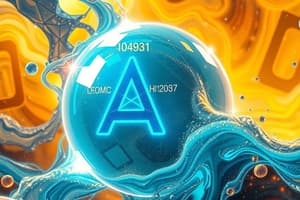Podcast
Questions and Answers
What is the highest degree obtained by Dr. Asmaa Fady?
What is the highest degree obtained by Dr. Asmaa Fady?
- JMHPE
- MBBCh
- MSc.
- PhD. (correct)
Which of the following degrees does Dr. Asmaa Fady NOT hold?
Which of the following degrees does Dr. Asmaa Fady NOT hold?
- JMHPE
- MSc.
- MBA (correct)
- MBBCh
In which field is Dr. Asmaa Fady's PhD likely to be awarded?
In which field is Dr. Asmaa Fady's PhD likely to be awarded?
- Social Work
- Medical Education (correct)
- Public Health
- Business Administration
What is the role of Dr. Asmaa Fady based on the information provided?
What is the role of Dr. Asmaa Fady based on the information provided?
Which college is associated with Dr. Asmaa Fady?
Which college is associated with Dr. Asmaa Fady?
Which drug is primarily used for treating glaucoma?
Which drug is primarily used for treating glaucoma?
What is the primary adverse effect associated with carbamate esters?
What is the primary adverse effect associated with carbamate esters?
Which drug is indicated for treating myasthenia gravis and has a half-life of 3-6 hours?
Which drug is indicated for treating myasthenia gravis and has a half-life of 3-6 hours?
Which drug is effective for curare toxicity?
Which drug is effective for curare toxicity?
Which statement is true regarding the action of these carbamate esters?
Which statement is true regarding the action of these carbamate esters?
Which drug has a longer half-life of 4-8 hours among the options?
Which drug has a longer half-life of 4-8 hours among the options?
What class of action does physostigmine exhibit?
What class of action does physostigmine exhibit?
What is the effect of cholinergic neuron deficiency in Alzheimer’s disease?
What is the effect of cholinergic neuron deficiency in Alzheimer’s disease?
What types of actions do all anticholinesterases exhibit?
What types of actions do all anticholinesterases exhibit?
Which characteristic is true for some anticholinesterases?
Which characteristic is true for some anticholinesterases?
Which type of drug effects are attributed to lipid-soluble anticholinesterases?
Which type of drug effects are attributed to lipid-soluble anticholinesterases?
What is one of the main properties of anticholinesterases?
What is one of the main properties of anticholinesterases?
Which of the following statements about anticholinesterases is incorrect?
Which of the following statements about anticholinesterases is incorrect?
Which of the following best describes the actions of anticholinesterases?
Which of the following best describes the actions of anticholinesterases?
Which of the following is NOT a CNS manifestation?
Which of the following is NOT a CNS manifestation?
Which CNS manifestation is characterized by an involuntary shaking movement?
Which CNS manifestation is characterized by an involuntary shaking movement?
Which of these symptoms involves a loss of awareness and responsiveness?
Which of these symptoms involves a loss of awareness and responsiveness?
Which symptom indicates a state of extreme mental confusion and disorientation?
Which symptom indicates a state of extreme mental confusion and disorientation?
Which of the following symptoms is characterized by an extreme state of worry or fear?
Which of the following symptoms is characterized by an extreme state of worry or fear?
Which CNS manifestation can result from various neurological conditions, presenting as a severe headache?
Which CNS manifestation can result from various neurological conditions, presenting as a severe headache?
Which of the following symptoms can lead to a deep state of unresponsiveness?
Which of the following symptoms can lead to a deep state of unresponsiveness?
Flashcards
Ph.D.
Ph.D.
A doctor's qualification indicating they have completed a doctorate in medicine.
MSc.
MSc.
A medical degree indicating the completion of a Master of Science in a specific medical subject.
MBBCh.
MBBCh.
A medical degree indicating the completion of a Bachelor of Medicine and Bachelor of Surgery.
Anticholinesterases
Anticholinesterases
Signup and view all the flashcards
Muscarinic and Nicotinic Actions
Muscarinic and Nicotinic Actions
Signup and view all the flashcards
CNS Effects of Anticholinesterases
CNS Effects of Anticholinesterases
Signup and view all the flashcards
Clinical Uses of Anticholinesterases
Clinical Uses of Anticholinesterases
Signup and view all the flashcards
Side Effects of Anticholinesterases
Side Effects of Anticholinesterases
Signup and view all the flashcards
Diversity of Anticholinesterases
Diversity of Anticholinesterases
Signup and view all the flashcards
Headache
Headache
Signup and view all the flashcards
Dizziness
Dizziness
Signup and view all the flashcards
Tremor
Tremor
Signup and view all the flashcards
Restlessness
Restlessness
Signup and view all the flashcards
Anxiety
Anxiety
Signup and view all the flashcards
Confusion
Confusion
Signup and view all the flashcards
Convulsion
Convulsion
Signup and view all the flashcards
What are Carbamate esters?
What are Carbamate esters?
Signup and view all the flashcards
What are the actions and uses of Physostigmine?
What are the actions and uses of Physostigmine?
Signup and view all the flashcards
What are the actions and uses of Neostigmine?
What are the actions and uses of Neostigmine?
Signup and view all the flashcards
What are the actions and uses of Pyridostigmine?
What are the actions and uses of Pyridostigmine?
Signup and view all the flashcards
What are the actions and uses of Ambenonium?
What are the actions and uses of Ambenonium?
Signup and view all the flashcards
What is the primary adverse effect of carbamate esters used in Alzheimer's disease?
What is the primary adverse effect of carbamate esters used in Alzheimer's disease?
Signup and view all the flashcards
Where do Carbamate esters primarily exert their action?
Where do Carbamate esters primarily exert their action?
Signup and view all the flashcards
How are Carbamate esters used to treat Alzheimer's disease?
How are Carbamate esters used to treat Alzheimer's disease?
Signup and view all the flashcards
Study Notes
Indirect Cholinergic Drugs
-
Cholinergic drugs mimic or enhance the effects of acetylcholine (ACh), a neurotransmitter.
-
Indirect cholinergic drugs, also called anticholinesterases, work by inhibiting the enzyme acetylcholinesterase, preventing the breakdown of ACh. This results in increased ACh concentrations and subsequent stimulation of cholinergic receptors.
-
Anticholinesterases have various actions, including muscarinic and nicotinic actions, as well as potential effects in the central nervous system (CNS).
Learning Objectives
-
Students should be able to classify indirect-acting cholinomimetics.
-
Describe the mechanism of action, kinetics, dynamics, and applications of anticholinesterases.
-
Identify the main side effects and contraindications of anticholinesterases.
-
Describe organophosphate toxicity's symptoms and treatment.
-
Identify the key side effects of direct cholinomimetics.
Classification
-
Cholinergic agonists are categorized into direct-acting and indirect-acting.
-
Direct-acting agonists directly stimulate cholinergic receptors.
-
Indirect-acting agonists work by inhibiting acetylcholinesterase.
-
Anticholinesterases are further classified as reversible or irreversible.
Indirect Cholinergic Drugs (Anticholinesterases)
-
Anticholinesterases structurally resemble ACh.
-
They bind to cholinesterase instead of ACh.
-
Mechanism of Action: Anticholinesterases stop ACh hydrolysis by the cholinesterase inhibiting the enzyme, thus resulting in increased ACh concentrations and actions on cholinergic receptors.
-
Anticholinesterase effects occur at muscarinic and nicotinic receptors, and in the neuro muscular junction and CNS.
Anticholinesterases: Reversible Agents
-
Short-Acting: Alcohol, Edrophonium
-
Intermediate-Acting: Carbamate esters (Physostigmine, Neostigmine, Pyridostigmine, Ambenonium)
Anticholinesterases: Irreversible Agents
- Very Long-Acting: Phosphate esters (Isoflurophate, Ecothiophate)
Pharmacological Actions of Indirect Cholinergic Drugs
-
All anticholinesterases have muscarinic and nicotinic effects.
-
Some anticholinesterases can affect the CNS, but only those that are lipid-soluble.
Muscarinic Actions
- Eye: Miosis, contraction of ciliary muscles
- Heart: Bradycardia, NO release, vasodilation
- Lung: Bronchial constriction, increased secretions
- Gastrointestinal (GI) Tract: Increased motility, sphincter relaxation, increased secretions
- Urinary Bladder: Contraction of muscles, sphincter relaxation
- Exocrine Glands: Increased secretions (sweat, saliva, tears, etc.)
Nicotinic Actions
- Neuromuscular junction: Therapeutic dose causes muscle contraction; toxic dose causes paralysis. This action is at the neuro muscular junction
- Ganglia: Stimulates both sympathetic and parasympathetic ganglia.
- Adrenal medulla: Causes catecholamine release (epinephrine and norepinephrine).
Reversible Anticholinesterase Agents: Details
-
Edrophonium: Short-acting, primarily peripheral action, used for diagnosing myasthenia gravis.
-
Physostigmine: Intermediate-acting, penetrates CNS, used for glaucoma and reversing anticholinergic toxicity.
-
Neostigmine: Intermediate-acting, doesn't penetrate CNS, used for myasthenia gravis.
Adverse Effects of Anticholinesterases
- Parasympathetic excess: Sweating, salivation, flushing, diaphoresis, nausea, abdominal pain, diarrhea, urinary urgency, decreased BP, bradycardia, bronchospasm.
Organophosphate Toxicity
-
Highly toxic compounds, including nerve gases and insecticides.
-
Irreversible inhibition of acetylcholinesterase.
-
Muscarinic and nicotinic effects similar to those of anticholinesterases, leading to the increased concentration of ACh
-
CNS effects include headache, dizziness, tremor, restlessness, anxiety, confusion, convulsions, coma.
Treatment of Organophosphate Toxicity
- Supportive measures (maintaining respiration).
- Atropine: Blocks muscarinic receptors.
- Pralidoxime (2-PAM): Reverses the effects of organophosphates (if given before aging of enzyme)
Summary Table of Anticholinesterase Agents
(Refer to provided table for specific details on these agents).
Summary of Other Information
-
Donepezil: Used in Alzheimer's disease; primarily CNS action. GI distress is a side effect.
-
Key drugs for various conditions (e.g., glaucoma, myasthenia gravis, Alzheimer's disease) are detailed in the provided summary tables.
Studying That Suits You
Use AI to generate personalized quizzes and flashcards to suit your learning preferences.




